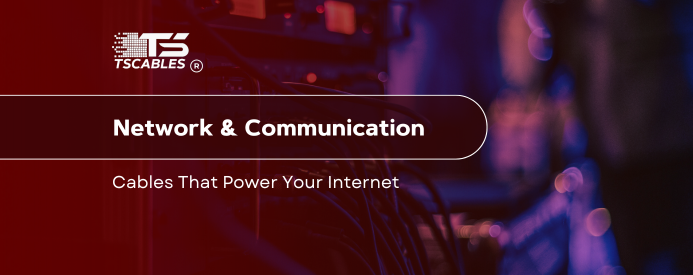Your internet link depends on hidden threads of copper and light. These network cable categories carry voice, text, video, and connections through walls and across cities. Yet, not all wires are equal. A careful pick requires knowing the different types of communication cables that boost speed, durability, or cost control.
This guide explores twisted pair, coaxial, fiber, and shielded options. We’ll talk about real use, from commercial network cabling to your home office. By the end, picking between copper and fiber, shielded or unshielded, will feel clear, straightforward, and right for your setup. So, without further ado, let’s get right into it.
Twisted Pair Network Cable Types & Standards
Twisted pair cables form the backbone of most wired internet. They feature pairs of wires twisted together to cut interference. Standards like Cat5e, Cat6, and Cat6A define speed and shielding. These networking wire types are common in homes, offices, and schools.
Installation follows specific grade and length rules. They're cost-effective for local area networks. Choosing the right category impacts speed and future-proofing. Let’s explore popular types:
- Cat5 – Older standard, supports up to 100 Mbps speeds over 100 meters.
- Cat5e – Up to 1 Gbps, good for most home and small-office needs.
- Cat6 – Supports 10 Gbps short runs; ideal for current and future setups.
- Cat6A – Handles 10 Gbps over longer distances; heavier and more shielded.
- Cat7 – Higher shielding, delivers 10 Gbps at higher frequencies, mainly for professional or industrial setups.
- Cat8 – Built for data centers, supports up to 40 Gbps over short distances (up to 30 meters).
Each cable has specs for shielding, speed, and maximum length. The right one depends on your needs, budget, and layout.
Shielded or Unshielded Twisted Pair Network Cable
Twisted-pair cables come in shielded (STP) or unshielded (UTP) forms. Shielding involves extra metal wraps to block noise, which is key in noisy environments like factories. Flexible cabling that doesn’t have shielding saves cost and bends easily.
If your setup has fluorescent lights, motors, or elevator wiring, shielded cables can help. However, UTP is simpler and fits most home and office needs. Many cables and connectivity kits include UTP variants. The choice helps strike a balance between performance, flexibility, and cost.
What Is Coaxial Network Cable?
Coaxial cable looks different from Ethernet cables. It includes a central wire, insulation, a braided shield, and an outer jacket. This design provides strong interference protection. That makes this type of computer cable ideal for cable internet and TV systems.
They handle high-frequency signals and distances well. You’ll find them in older home networks and in many ISPs’ setups. Coax also carries multiple wireless signals through splitters. Though fiber is gaining ground, coax remains widespread for last-mile delivery and mixed-use cabling.
What Is Fiber Optic Cable?
Fiber optic cables carry data as pulses of light. That makes them faster with more gigabits per second, even across cities. They include a glass core, cladding layers, and protective jackets. Fibers are immune to electrical interference and can stretch for miles without losing speed.
These commercial network cabling options fit data centers, campuses, and long-haul circuits. They come in single-mode and multi-mode types. Though pricier and more fragile than copper, fiber delivers future-proof performance at scale.
Which One to Choose For Your Needs?
Different setups require different cabling. Matching cable type to your usage ensures reliability without wasted cost. Here are key scenarios to guide your pick: Before diving into details, here are the main options:
- Ethernet copper (Cat5e, Cat6, Cat6A)
- Shielded vs. unshielded materials
- Coax for cable internet
- Fiber for long-distance, high-speed needs
Now you can match those cables to your layout and goals.
Home Networks and Gaming
Home setups often rely on Cat5e or Cat6. They’re affordable and easy to install. Gamers benefit from wired links using cables of type Cat6 for stability and speed.
Small Office and Remote Work
With multiple Wi‑Fi devices and VoIP service, Cat6A or shielded Cat6 helps reduce interference. It cleanly supports most teams without extra cost.
Multi‑Story Buildings or Condos
Long copper runs lose speed. Fiber or coax becomes a better choice. They carry data far without slowdown, which makes them great for shared utility spaces and basements.
Commercial or Industrial Settings
Factories, warehouses, or labs require durable cable. Shielded twisted-pair, rugged fiber, or specialized cable types resist noise, moisture, or strain. They support heavy machinery and robust commercial network cabling needs.
ISP or Campus Backbones
Internet providers and campuses use fiber as the backbone. It delivers high speed across many nodes and builds. They may layer Ethernet or coax where the fiber ends.
Conclusion
Your network speed, reliability, and flexibility rely on cable choice. Different types of communication cables shine in different spaces, from gaming rooms to campus backbones. Therefore, you should choose the right one to match the cable to the signal, distance, and environment. TS Cables supplies premium copper, coax, and fiber options built to suit every setup.
FAQs
Which cable is best for home internet?
Cat6 cable strikes a strong balance of speed, cost, and ease of installation for most home networks.
Is shielded cable necessary at home?
Shielding helps in noisy electrical environments. However, in standard homes, unshielded options perform just fine.
Can coax connect my modem to the router?
Yes. Cable internet often uses coax for modem input, then Ethernet cable to link from the modem to the router.
What’s the max length for Ethernet cable?
Standards limit Cat5e/Cat6 runs to 100 meters (328 feet) before signal degradation becomes noticeable.
Do I need fiber at home?
Only if you need ultra-high speed or plan future upgrades beyond what copper can reliably manage.






